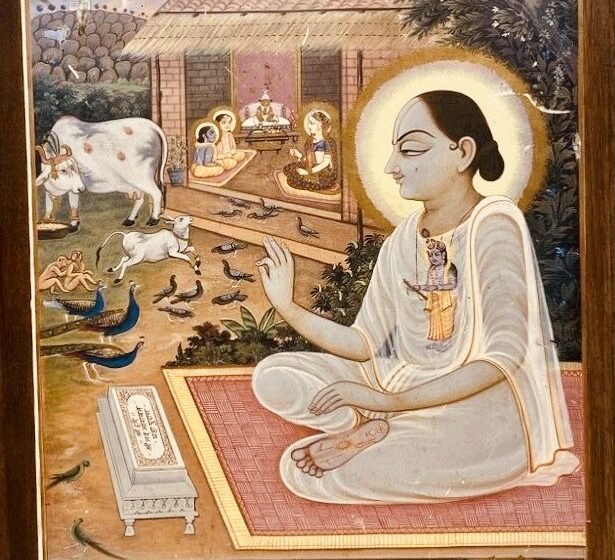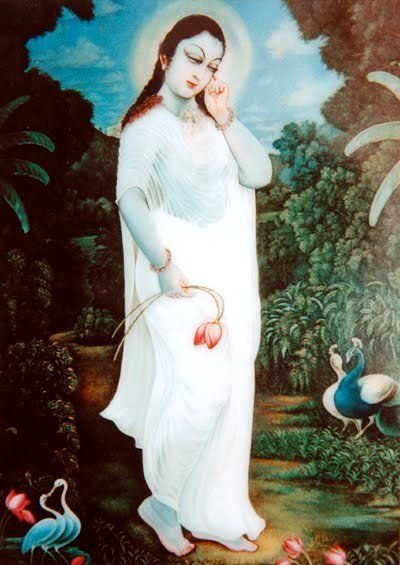Vallabhacharya: The Devotional Philosopher

Vallabhacharya, also known as Vallabha, was a 16th-century Indian saint, philosopher, and the founder of the Puṣṭimārga sect of Vaishnavism. His life and teachings left an indelible mark on spiritual thought and cultural practices in India.

Vallabhacharya was born around 1479 CE in the region of Braj (Vraja), which encompasses present-day Uttar Pradesh, India. His family belonged to the Velanāṭa Telugu Brahmins, and he studied Hindu philosophy from an early age. His spiritual quest led him on a journey across the Indian subcontinent for over two decades. Vallabhacharya founded the Kr̥ṣṇa-centred Puṣṭimārga sect, emphasising loving devotion (bhakti) to Lord Krishna. His philosophy, known as Śuddhādvaita, asserts that the soul is eternally connected to Krishna and can achieve salvation through unwavering love. Vallabhacharya engaged in scholarly debates, particularly against followers of Advaita Vedānta. His eloquence and philosophical acumen established him as a prominent leader of the Bhakti movement. He initiated the institutional worship of Śrī Nāthajī on Govardhana Hill. This marked a significant shift from asceticism to devotion within the householders’ context. Vallabhacharya authored several texts, including the Aṇubhāṣya (his commentary on the Brahma Sutras) and the Ṣoḍaśa Grantha (sixteen tracts). His commentaries on the Bhāgavata Purāṇa remain influential.

Vallabhacharya’s teachings continue to inspire devotees seeking a direct connection with Krishna. His emphasis on love, devotion, and grace resonates across generations.
Temples dedicated to Vallabhacharya dot the Gangetic plain and Gujarat. His legacy lives on through devotional music, dance, and artistic expressions. By rejecting asceticism and advocating devotion for householders, Vallabhacharya challenged societal norms. His life exemplified courage, faith, and unwavering commitment. Vallabhacharya’s philosophy is known as Śuddhādvaita Vedanta or pure dualism. According to him, the soul (jīva) is separate from God (Brahman), and the ultimate aim of the soul is to realise God. He loves devotion (bhakti) as the path to salvation. Vallabhacharya instituted the Puṣṭimārga sect, centred around devotion to Lord Krishna. This path shows God’s grace (pushti) and the soul’s surrender to Krishna. It encourages a life of devotion, service, and love. Vallabhacharya’s commentaries on the Brahma Sutras and the Bhagavad Gita are significant. He interpreted these texts in the context of devotion and grace. His teachings align with the idea that God’s grace is essential for spiritual realisation . Vallabhacharya’s teachings showcase that God’s grace is available to all, regardless of caste, gender, or social status. His path of devotion is inclusive, allowing everyone to seek union with the divine. Unlike ascetic traditions, Vallabhacharya believed that householders could attain salvation. He encouraged people to live in the world, fulfil their duties, and cultivate love for Krishna. His teachings bridged the gap between spirituality and everyday life . Vallabhacharya charity (dāna) and compassion (dayā). He advocated for helping the hungry, weak, and less fortunate. His teachings inspire selflessness and kindness.

Vallabhacharya’s philosophy centred around pure devotion (bhakti) to Lord Krishna. He believed that God’s grace was essential for spiritual realisation. As a result, temple rituals shifted from mere rituals to heartfelt acts of devotion. Vallabhacharya founded the Puṣṭimārga sect, which show loving service to Krishna. In Puṣṭimārga temples, worship is not a formal duty but an expression of love. Devotees engage in sevā (service) by offering food, clothing, and other items to the deity. Vallabhacharya encouraged devotees to establish a personal relationship with the deity. Temple rituals became more intimate, allowing individuals to express their love and devotion directly. The deity was no longer distant but a beloved companion. Puṣṭimārga temples involve the entire community. Devotees participate in prasad distribution, singing devotional songs, and decorating the deity. The temple becomes a vibrant centre of communal worship and celebration. Vallabhacharya advocated for simple rituals performed with utmost sincerity. Elaborate ceremonies were replaced by heartfelt gestures. Devotees offer bhog (food offerings) to Krishna, symbolising their love and gratitude. Temple rituals shifted from seeking blessings to pleasing the deity. Devotees serve Krishna as if he were a beloved guest. The deity’s happiness becomes the primary goal of worship. Vallabhacharya viewed the temple as a sacred abode where the divine and the devotee could connect intimately. He emphasised that the temple structure should symbolise this connection. The garbhagriha (sanctum sanctorum) represented the womb of creation, where the deity resided. It symbolised the divine presence within the heart of the devotee. The mandapa (assembly hall) and other architectural elements were designed to facilitate congregational worship and community participation.

Vallabhacharya believed that the deity’s iconography should evoke love and devotion. The deity’s form, posture, and expressions were essential. The placement of iconographic representations within the temple had a symbolic purpose. For example:
The deity’s murti (image) in the garbhagriha represented the divine seed, akin to a seed planted in the womb of creation.
The kalasha (water pot) hidden beneath the main deity symbolised the seed of consciousness from which all existence emerged.
Vallabhacharya advocated for simple temple rituals performed with utmost sincerity. Elaborate ceremonies were secondary to heartfelt devotion. The focus shifted from external grandeur to inner devotion. The deity’s pleasure became paramount. Vallabhacharya’s teachings emphasise a personal relationship with the deity. He encouraged devotees to see the deity as a beloved companion. Temple architecture and iconography aimed to evoke love, intimacy, and grace. Devotees engaged in seva (service) with devotion.

Vallabhacharya’s philosophy, known as Śuddhādvaita Vedanta, is his pure devotion (bhakti) to Lord Krishna. Unlike some other Vaishnava schools, he believed in a personal relationship with the deity. His focus was on loving surrender and grace, rather than strict ritualism or impersonal worship. Vallabhacharya’s teachings influenced temple iconography by emphasising simplicity and sincerity. His approach was more intimate and heartfelt. Unlike certain Vaishnava traditions that emphasised elaborate rituals and complex symbolism, Vallabhacharya advocated for a direct connection between the devotee and the deity. Vallabhacharya’s view of temple architecture aligned with his philosophy. He saw the garbhagriha (sanctum sanctorum) as the womb of creation, where the deity resided. The placement of iconographic representations within the temple had symbolic significance, reflecting the soul’s connection with the divine. Vallabhacharya’s teachings were inclusive. He believed that any householder could attain salvation through devotion. His temples encouraged community participation, where devotees engaged in seva (service) with love and devotion. While some Vaishnava traditions emphasised elaborate rituals, Vallabhacharya’s approach was more about devotional aesthetics. His temples focused on the deity’s pleasure rather than external grandeur.

Vallabhacharya emphasised personal devotion and loving surrender to Lord Krishna. His iconographic representations aimed to evoke an intimate connection between the devotee and the deity. His approach favoured simple rituals performed with sincerity. The deity’s pleasure was paramount. Vallabhacharya saw the garbhagriha (sanctum sanctorum) as the womb of creation, where the deity resided. It symbolised the divine presence within the heart of the devotee.
Vallabhacharya’s emphasis on pure devotion and loving surrender to Lord Krishna inspired various art forms. His teachings encouraged artists to depict Krishna in intimate and emotive ways. The Puṣṭimārga tradition, founded by Vallabhacharya, influenced temple art. Devotional paintings, sculptures, and murals depicted Krishna’s playful interactions, divine love, and grace.

Vallabhacharya’s impact is prominent in Braj region (Mathura, Vrindavan), where Krishna’s playful forms are celebrated. Teachings of Vallabhacharya have left an indelible mark on Indian spirituality, culture, and art. Vallabhacharya’s emphasis on pure devotion and loving surrender to Lord Krishna transformed temple rituals into heartfelt acts of love.


